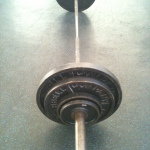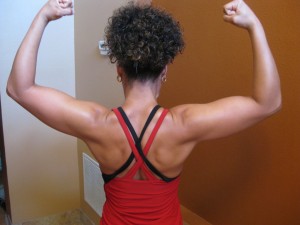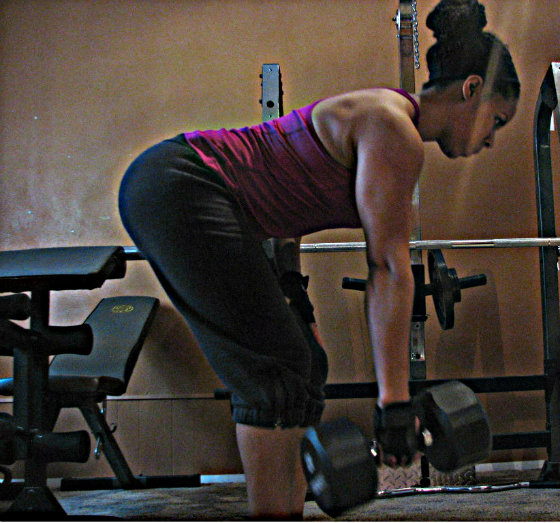Q: I don’t have a pull-up bar. Is it necessary? Is there a substitute or alternatives for pull ups?*
 A: There truly are no subs for the elusive pull ups. It is an amazing compound exercise that creates overall strength, and gives you that coveted v-taper (aka coke bottle shape), as well as shaping the biceps quite nicely. As an added bonus, it even hits the abs if you keep that core tight throughout the move. If at all possible, include them in your strength routines. There are many pull up bar systems out there, and most of them will do the trick. There are the kind that you drill into your doorway, the kind that attaches to your door frame, the stand-alone apparatus, or even the assisted machines at the gym. If nothing else, there’s always a local park nearby, where you can stop and get your pull ups on once a week on the monkey bars.
A: There truly are no subs for the elusive pull ups. It is an amazing compound exercise that creates overall strength, and gives you that coveted v-taper (aka coke bottle shape), as well as shaping the biceps quite nicely. As an added bonus, it even hits the abs if you keep that core tight throughout the move. If at all possible, include them in your strength routines. There are many pull up bar systems out there, and most of them will do the trick. There are the kind that you drill into your doorway, the kind that attaches to your door frame, the stand-alone apparatus, or even the assisted machines at the gym. If nothing else, there’s always a local park nearby, where you can stop and get your pull ups on once a week on the monkey bars.
With exception to the stand alone unit, or the assisted machine, most pull up bars can be found relatively cheap. I never fail to see one on a trip to my local Ross or Walmart, and they run right around $20. A relatively low cost for such a useful tool. However, if you’ve already invested as much $$ as you’re willing to invest in your home gym, there could be other options, depending on the equipment you have. One in particular could be if you have a bench press set up with a sturdy (preferably Olympic-sized) bar and rack. With something like this you could set the rack as high as possible and either bend your knees behind you in order to mimic the pullup motion, and pull til your hearts content. If you’re not “height challenged” as I am, and your legs are too long to put behind you, you can either put them straight in front of you (keeping your body upright just as it would be in a traditional pull up), or cross them (this will make the move much harder). Another obvious substitute would be to use the Lat Pull-down machine, if you have access to one. Because the Lat pull-down is not necessarily a one-for-one sub, make the most of it by pulling as heavy as you can handle. Your goal here would be to work up to pulling your body weight, and then beyond…
If you do not have access to any of those and still need an at-home substitute, we would look to exercises that work the same muscles. The pullover would then become your next option, using either the straight-arm or bent-arm variation. Also, any rowing motion would work the lats as well as the back in general.
Still looking for a variation to suit you?
How about:
Inverted Row (feet elevated)
and there’s always the good ‘ol Barbell Row

Should you just do cardio to lose weight? How heavy is heavy lifting? Do "strength" DVDs count? What if you don't want to lift? Sign up now for in-depth info on strength training and fat loss. You'll also receive special vids and free workout plans to help you get the most from your time in the gym.
No worries, we hate spam too!
Discover more from Eat More 2 Weigh Less
Subscribe to get the latest posts sent to your email.





I’m doing NROLFW. I’m not yet up to the pullup exercises in it (although i do use resistance bands to do pulldowns in the early stage i’m in), but when i get to that part my plan is to go to the local children’s playground where they have monkey bars and use them!
i don’t like the idea of door frame bars as i don’t trust they won’t damage the paintwork on my rental property.
Love the monkey bar option, Angela! I’ve used two types of door frame pullup bars, the one that bolts into the frame is what I use now (which leaves obvious damage via the holes left behind when you remove it. A few years back, I was relegated to working out in my bedroom, and I had the Iron Gym, which is the one that is not permanent. It was awesome, though it did leave behind the slightest scuff marks from the black foam part that “protects” the frame from the metal. It wasn’t a huge deal for me, because it was just two very small marks that were easily removed w/a Mr Clean magic eraser. I loved the versatility of the Iron Gym.
Um….there’s a Total Gym machine hiding in the back of the closet. Would it be possible to use it for something pull-up like? Actually….could I use this for quite a bit of weight training stuff using body weight right now if I stick it on the higher to highest levels?
Yes, if you have your Total Gym set on the highest incline, you should be able to pull your body weight in a diagonal fashion, simulating an assisted pullup (I say “assisted”, as the gliding board will make the move slightly easier).
I’m a beginner, and extremely week in the upper body. Never in my life have I been able to do them. How do i build the strength up to be able to do a pull up?
Hey Roxanne,
If you have access to an assisted pull-up machine at a gym, it’s a great tool for beginners. If not, here’s a move to you can do using either a pull-up bar at home or the lat pull-down machine at the gym: a “negative” version of the move, or simply doing the exercise in reverse. Working the move backwards, builds up the muscles and muscle memory to be able to do the normal version. Using a pull-up bar, take a chair over to the bar and use it to get you in position as if you’d just finished a pull-up. You should be standing on the chair, hands on the bar in chin-up /pull-up position, with arms bent & chin slightly above the bar. Bend your legs and try to hold as much of your body weight as possible at the top of the move for a 2 second count, then slowly lower down, trying not to use the chair until you’re back at the bottom of the move. Then, use the chair to get back in position and repeat. Try doing this 5 times on your first try. Then, when you can perform all 5 moves holding your entire bodyweight on the way down, add five more next time (resting 90 seconds between each set of 5). Work your way up to 5 sets of 5 negative repetitions. To do this using the lat machine, just load as much weight as you can handle (your goal is to be able to pull more than your bodyweight eventually). Pull the weight down fast, hold the move at the bottom, and release slowly (about 3-5 seconds).
You should feel your lat muscles in your back for DAYS after doing this move, when done properly. So don’t rush the recovery process & wait until you have no muscle soreness before attempting again. You will quickly develop the strength needed to do pull-ups, and can use this method whenever you want to increase your pull-up #s